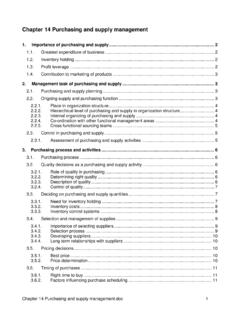Transcription of Understanding Cryptocurrencies
1 IRTG 1792 Discussion Paper 2018-44 Understanding Cryptocurrencies Wolfgang Karl H rdle* Campbell R. Harvey * Raphael C. G. Reule * * Humboldt-Universit t zu Berlin, Germany. Wang Yanan Institute for Studies in Economics, Xiamen University, China. Sim Kee Boon Institute for Financial Economics, Singapore Management University, Singapore. Faculty of Mathematics and Physics, Charles University, Czech Republic. * Duke University, Durham, NC, USA. National Bureau of Economic Research, Cambridge MA, USA. *3 Humboldt-Universit t zu Berlin, Germany. This research was supported by the Deutsche Forschungsgemeinschaft through the International Research Training Group 1792 "High Dimensional Nonstationary Time Series". ISSN 2568-5619 International Research Training Group 1792 Understanding CryptocurrenciesWolfgang Karl H ardleHumboldt-Universit at zu Berlin, Yanan Institute for Studies in Economics, Xiamen University, Kee Boon Institute for Financial Economics, Singapore Management University, of Mathematics and Physics, Charles University, Czech [at] R.
2 HarveyDuke University, Durham, NC, Bureau of Economic Research, Cambridge MA, [at] C. G. ReuleHumboldt-Universit at zu Berlin, [at] August 2019 AbstractCryptocurrency refers to a type of digital asset that uses distributed ledger, orblockchain, technology to enable a secure transaction. Although the technologyis widely misunderstood, many central banks are considering launching their ownnational cryptocurrency. In contrast to most data in financial economics, detaileddata on the history of every transaction in the cryptocurrency complex are freelyavailable. Furthermore, empirically-oriented research is only now beginning, present-ing an extraordinary research opportunity for academia. We provide some insightsinto the mechanics of Cryptocurrencies , describing summary statistics and focusingon potential future research avenues in financial Classification: C01, C58, E42, E51, G10, K24, K42, L86, O31 Keywords: Cryptocurrency, Blockchain, bitcoin, Economic bubble, Peer-to-Peer, Finance,Cryptographic hashing, Consensus, Proof-of-work, Proof-of-stake, VolatilityT he f inancial support of Czech Science F oundation under grant 28231X IntroductionIn 2008, the pseudonymous Satoshi Nakamoto posted a white paper describing animplementation of a digital currency called bitcoin that used blockchain technology.
3 Morethan ten years later, hundreds of Cryptocurrencies and innumerable other applications ofblockchain technology are readily rise of Cryptocurrencies poses an existential threat to many traditional functionsin finance. Cryptocurrencies embrace a peer-to-peer mechanism and effectively eliminatethe middle man , which could be a financial institution. For example, no bank account orcredit card is needed to transact in the world of Cryptocurrencies . Indeed, a cryptocurrency wallet serves the same function as a bank vault. With a smart phone and the internet,the potential exists for a revolution in financial inclusion given that over two billionpeople are unbanked (GlobalFindex, 2017; World Bank, 2017).The technology, however, goes well beyond providing banking services to the holds the potential for cheap, secure, and near-instant transactions, allowing billionsof people to join the world of internet commerce, paying, and being paid, for goods orservices, outside of the traditional banking and credit card transactions potentially enable near real-time micropayments.
4 Creditcards are not designed to be used for a one-cent charge to download, for example, aproduct or service from the internet. Cryptocurrency systems promise to make micropay-ments seamless and allow businesses to offer real-time pay-per-use consumption of theirproducts, such as video, audio, cell phone service, utilities, and so cryptocurrency like bitcoin can be thought of as a decentralized autonomous organi-zation (DAO), an open-source peer-to-peer digital network that enforces the rules it isset up with. In this DAO setting, the money supply is set by an algorithmic rule,and the integrity of the network replaces the need to trust the integrity of humanparticipants. The growth of crypotcurrency technology therefore poses a challenge totraditional monetary authorities and central banks, as Facebook s Libra coin pre-emission market acceptance suggests (Taskinsoy, 2019).
5 Central banks understand this,and many banks have initiated their own national cryptocurrency initiatives (Bech andGarratt, 2017).As with any new technology, risks are present. In the nascent cryptocurrency market,one concern involves the anonymous nature of transactions in some Cryptocurrencies ,which could allow nefarious actors to conduct illegal business, or worse, to pose a broader2threat to our society and institutions (Foley et al., 2018). The benefits, such as lowtransaction cost, security and the promise of quick processing, are readily measurable,but quantifying the risks is less our view, any new technology involves risks; if we require no risk, innovationis constrained (Catalini and Gans, 2016). Cryptocurrencies have, in contrast to manymarkets, a plethora of available and free data, ripe for empirical investigation. We arejust now seeing the genesis of academic research focusing on this emerging technology(Harvey, 2014, 2017a, 2017b; H ardle et al.)
6 , 2018; Kim et al., 2019).We have four goals in this paper. First, we explain the mechanics of cryptocurrenciesat a high level. Second, we detail useful data sources for researchers. Third, we providebasic summary statistics given the available data. Finally, we offer a list of possibleresearch Cryptocurrencies and BlockchainsThe concept of supplementary (Delmolino et al., 2016), alternative (Ametrano, 2016), ordigital currencies (Chaum, 1983) is not new, but the concept of an open-source currencywithout a central point of trust, such as a central distribution agency or state lead control,is new (King and Nadal, 2012). A cryptocurrency is a digital asset designed to work as amedium of exchange using cryptography to secure transactions, to control the creation ofadditional value units, and to verify the transfer of assets. Many different cryptocurrenciesexist, each with their own set of rules, see, for example, (Iwamuraet al.
7 , 2014; Abraham et al., 2016; Bartos, 2015; Park et al., 2015). Differences amongthe Cryptocurrencies may involve, for example, the choice of the consensus mechanism,the latency, or the cryptographic hashing High-level description of blockchainAbadi and Brunnermeier (2018) describe a blockchain trilemma, that no ledger cansatisfy all ideal qualities of any recordkeeping system correctness, decentralization,and cost efficiency simultaneously. Yet, a blockchain is more efficient than a centrallymanaged traditional ledger (Babich and Hilary, 2018a). A blockchain can be implementedin many ways, but most share several common features. We can think of a blockchain asa very special database. A blockchain s structure is shared, ordistributed, rather thancentralized, and thus is often referred to as distributed ledger technology (DLT). Figure 1shows a distributed network. As we discuss later, the distributed network provides somelevel of security, because it is unlikely an attack can be launched on every copy of the3database.
8 Distributed databases are not new, and most distributed databases are notblockchains. The key difference between a regular distributed database and one set on ablockchain is the structure (Babich and Hillary, 2018b).A blockchain is divided into subsheets of data, each one called ablock. At the end ofeach block is adigestthat summarizes the contents of the block. The digest is repeatedas the first line of the next block. If any change is made in the content of a historicalblock, the digest changes for that block and it will not match the first line of the nextblock. When the network detects such an inconsistency, it throws out the corruptedblock and replaces the block with the original. In this sense, the database is this structure ( , data organized in blocks with updates to the blockchain beingappend-only, based on the respective consensus mechanism), it is extremely unlikely thathistory can be rewritten.
9 The digest at the end of a block and at the beginning of thenext is generated by a cryptographic hashing function.(a) centralized (b) Decentralized(c) DistributedFigure 1: Types of presented numerical and pictoral examples shown are reproducible and can befound (Borke and H ardle, 2018). HashingA hash function is a one-way mathematical algorithm that takes an input and transformsit into an output, known as thehashordigest. Hashing functions have a long history incomputer science and are integral to the blockchain technology. Hashing should not beconfused with encryption. With encryption, a file is encrypted with a key and decryptedwith a key. Hashing has no decryption step. Additionally, a good hashing algorithmmakes it computationally infeasible to find two input values that produce the same hashvalue (output); this is known ascollision resistance(Paar and Pelzl, 2010; Derose, 2015;Harvey, 2016).
10 4 One common cryptographic hashing algorithm, the Secure Hash Algorithm (SHA-256), has a maximum input size of 264-1 bits (more than 2 million terabytes) and anoutput of 256 bits. We usually represent the SHA-256 output in hexadecimal form, alsocalled base 16 (the characters 0-9 and a-f). In order to make the theoretical maximal inputsize more visual, we assume that 1 bit equals to 1 mm2. A soccer field has the dimensionsof 7,140 m2, therefore 264-1 bits could theoretically fill 2,583,577,601 soccer fields. As thewhole surface of the earth equals to 510,000,000,000,000 m2, we could also cover around36170 times the earth with the theoretical input size. This input information will bestored in a very short output, the hash. If just one piece of the input, like for example ablank space or a comma, is changed, then the hash output be completely , the digest does not reveal the original information.








